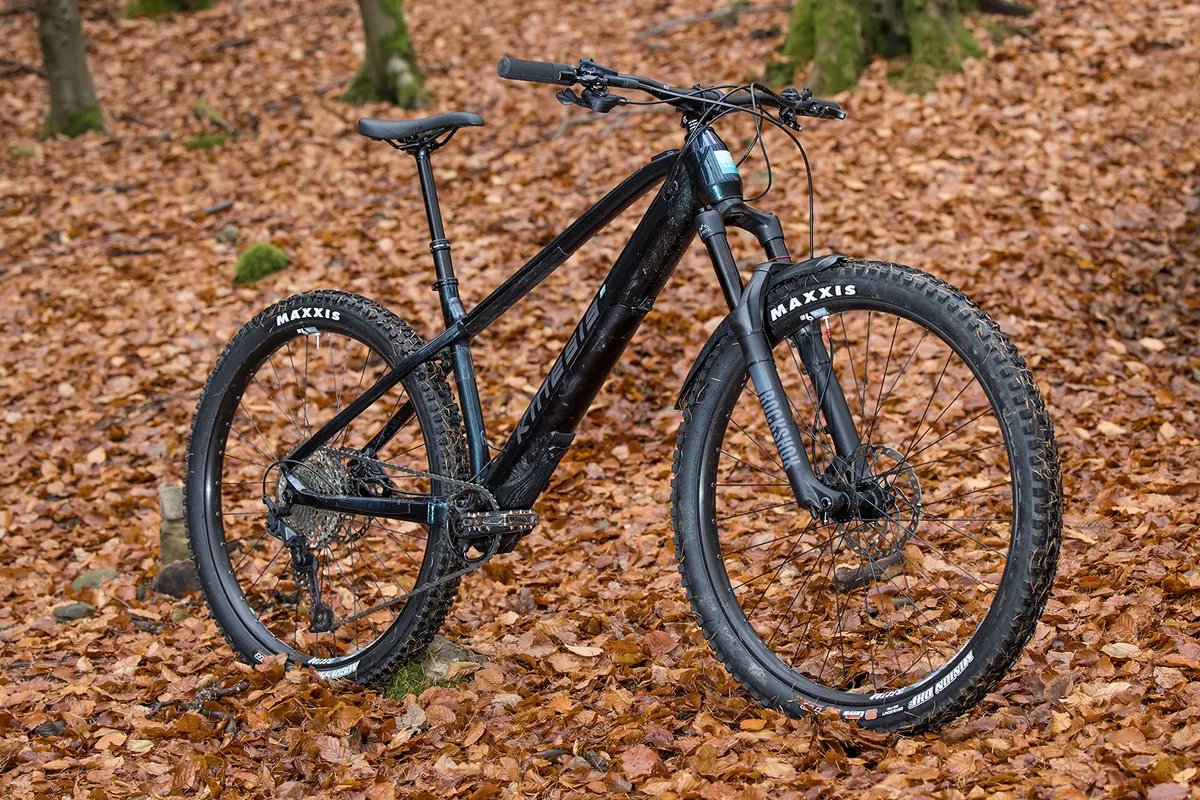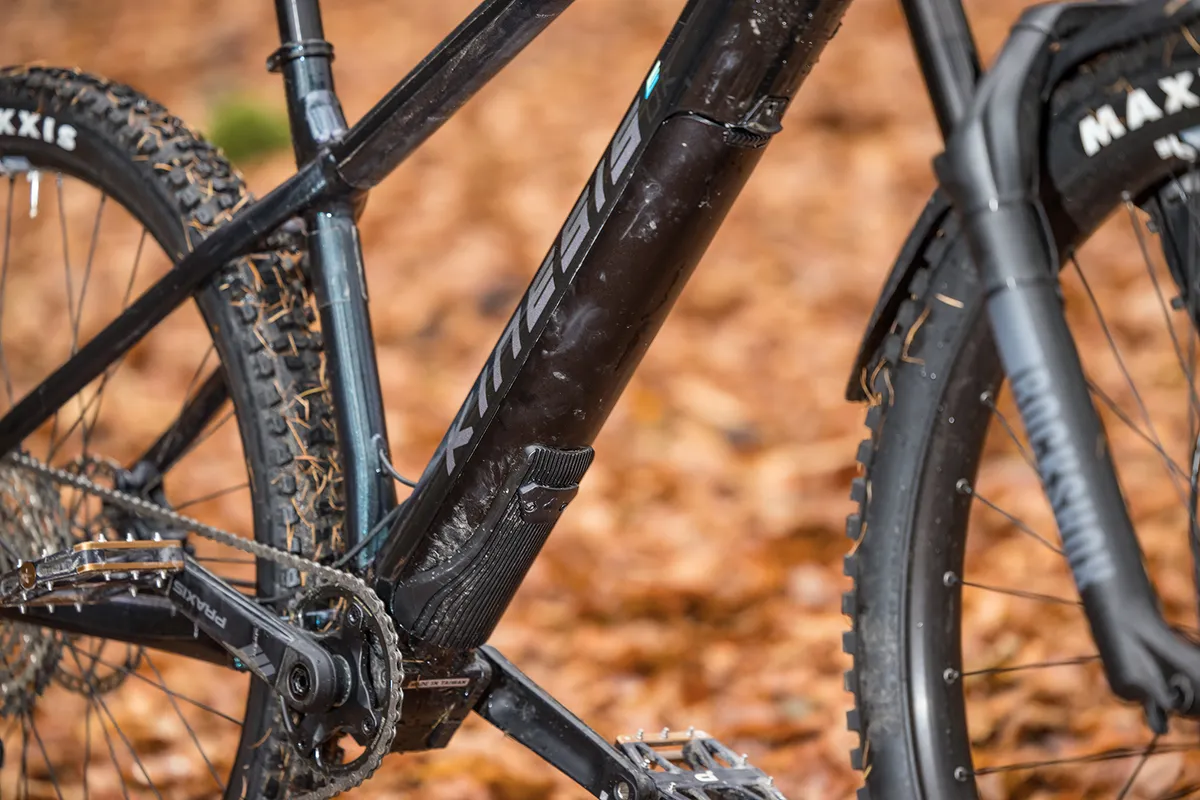Kinesis’s Rise is a unique bike, combining the electrical assistance of a removable, modular motor with relatively progressive geometry and hardcore components on an aluminium hardtail chassis.
It’s designed to be the perfect no-nonsense trail companion.
Kinesis Rise Pro frame and geometry

Built from hydroformed 6061 aluminium tubing, the Rise houses its Fazua Evation motor and 252Wh battery in its down tube. These can be removed and replaced with a blanking plate if you fancy riding without any help.
The drive unit delivers up to 252 per cent assistance and 55Nm of torque, operating most efficiently at pedalling cadences between 50 and 125rpm.
It takes only 50 degrees of crank rotation to engage the motor, which is operated using a touch-sensitive switch on the handlebar.
Frame features include Boost rear hub spacing (148×12mm), internally-routed gear, brake and dropper cables, and a single bottle cage mount on top of the down tube.
The L3 size I tested has a 65.5-degree head angle and 75.5-degree effective seat tube angle, a lengthy 485mm reach, 445mm chainstays and a 1,241mm wheelbase.
Sizing is based on reach, with the seat tube length only growing 65mm between the smallest (L1) and largest (L4) frames.
| | L1 | L2 | L3 | L4 |
|---|---|---|---|---|
| Seat angle (degrees) | 75.5 | 75.5 | 75.5 | 75.5 |
| Head angle (degrees) | 65.5 | 65.5 | 65.5 | 65.5 |
| Chainstay (cm) | 44.5 | 44.5 | 44.5 | 44.5 |
| Seat tube (cm) | 40 | 41.5 | 44 | 46.5 |
| Head tube (cm) | 12 | 12 | 12.5 | 14 |
| Fork offset (cm) | 4.4 | 4.4 | 4.4 | 4.4 |
| Bottom bracket drop (cm) | 5.5 | 5.5 | 5.5 | 5.5 |
| Wheelbase (mm) | 1,191 | 1,215 | 1,214 | 1,273 |
| Stack (cm) | 64 | 64 | 64.5 | 65.9 |
| Reach (cm) | 43.7 | 46.1 | 48.5 | 51 |
Kinesis Rise Pro kit
There’s just one Rise Pro model (the £450 cheaper Rise is an older version with different geometry), which has a Shimano SLX-based build. This means you get 12-speed gearing with a 10-51t cassette, plus four-pot brakes.
The fork is RockShox’ 35 Gold, with a stiff chassis and 130mm of travel, but basic Motion Control damper.
Wide (35mm, internal) Sector 9E rims are wrapped with Maxxis Minion DHF and Aggressor tyres.
The X-Fusion dropper post has 150mm of travel and a Shimano lever.
Things are finished off with a Kinesis bar and stem.
Kinesis Rise Pro ride impressions
The motor’s assistance is subtle, akin to riding with a tailwind. Full-power feels more like Bosch and Shimano’s middle Tour and Trail modes.
From a stop or when changing into a higher mode, the assistance ramps up gradually rather than feeling like an instantaneous shove.
There’s little lag between starting pedalling and the motor cutting in, though, which keeps things smooth and controlled on technical ascents. The motor cut-off after you stop pedalling is gradual too, further aiding control.
In the lowest setting, Breeze, there’s only enough assistance to tackle very gentle inclines and it barely compensates for the bike’s weight.
River mode is better, however, and this is where I spent most of my time. The Rocket setting provides ample assistance for most climbs, but uses lots of juice.
In mixed-mode usage on a single charge I managed 600m of climbing over 23km of riding before the battery was flat. Over the 15.5mph assistance limit, or if the battery is fully depleted, the motor decouples from the cranks and has no drag, which makes unassisted riding more pleasant.
The geometry feels good on the ascents, with the seat angle being suitable for most trail-centre-style climbs, although if it were marginally steeper it would improve comfort and control on more technical or precipitous ascents.
Thanks to that long reach, there’s plenty of space to move around when out of the saddle, and the top tube feels roomy when seated. The slack head angle didn’t cause a vague-feeling front end even when things got steep or technical.
Over bumps, the ride is quite punishing on your legs and feet. While this is a common trait of hardtails, the Rise feels particularly stiff, especially over rooty or rocky trails with harsh square-edged hits. The extra weight of the motor and battery compounds this effect.
I found I had to run higher tyre pressures than normal to avoid dinging the rims or tearing the EXO-casing tyres, which further reduced the smoothness of the ride
On less rough trails, even down steeper gradients, the slack head angle and generous reach help the Kinesis feel calm at speed. The RockShox Gold 35 fork performs well too, with its damper and chunky e-specific chassis proving tricky to overwhelm.
While the SLX brakes suffered from Shimano’s well-documented moving bite-point issue, they had more than enough oomph, even with 180mm rotors.
Once the motor’s cut-off is exceeded, powering the bike’s weight around requires plenty of strength and energy if you want to ride it as quickly as the chassis is capable of going.
You’ll get the most from the Rise on smoother, flatter trails where its heft and stiffness are less of an issue, and the subtle assistance provided in the lower power modes isn’t overwhelmed by the bike’s weight.
It’ll also suit someone who’s looking to improve their fitness while being able to ride with stronger and faster mates without getting dropped on every climb.
Product
| Brand | kinesis |
| Price | 3650.00 GBP |
| Weight | 19.8800, KILOGRAM (L3) - without pedals |
Features
| Fork | RockShox 35 Gold, 130mm (5.1in) travel |
| br_stem | Kinesis, 35mm |
| br_frame | 6061 aluminium |
| br_motor | Fazua evation motor with 252Wh BatteryX battery |
| Tyres | Maxxis Minion DHF EXO TR 3C MaxxTerra (f) and Maxxis Aggressor EXO TR (r) 29x2.5in WT |
| br_brakes | Shimano SLX M7120, 180mm rotors |
| br_cranks | Praxis |
| br_saddle | WTB Volt |
| br_wheels | Sector 9E wheels |
| br_shifter | Shimano SLX, 21spd |
| br_cassette | Shimano SLX 10-51 |
| br_seatpost | X-Fusion Manic dropper |
| br_handlebar | Kinesis, 800mm |
| br_availableSizes | L1, L2, L3, L4 |
| br_rearDerailleur | Shimano SLX |















